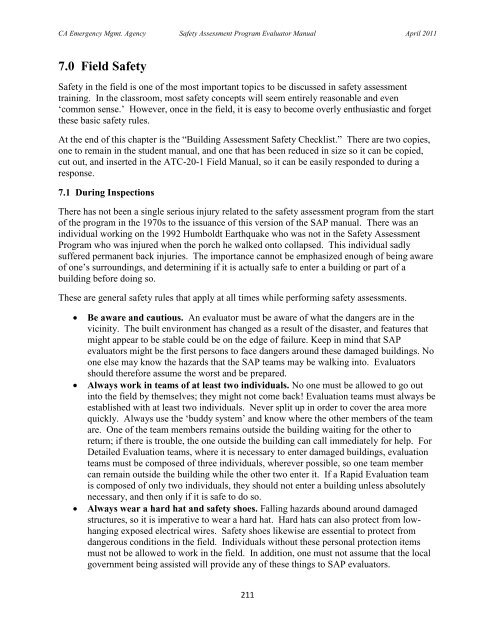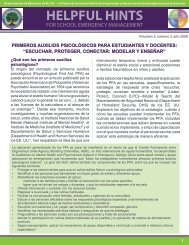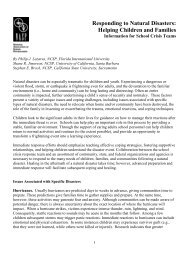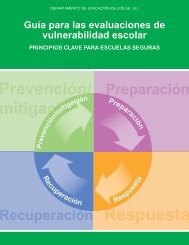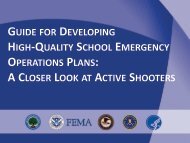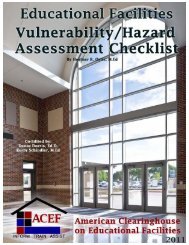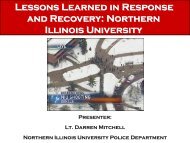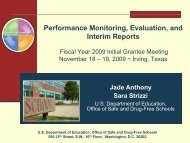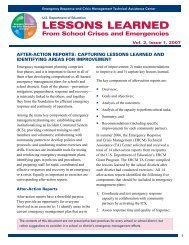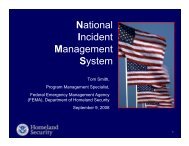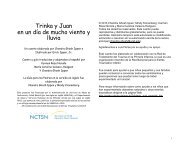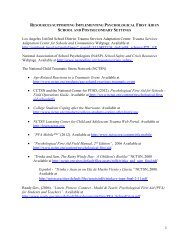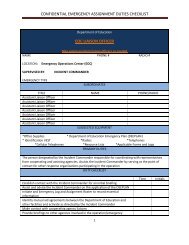Safety Assessment Program Evaluator Student Manual
Safety Assessment Program Evaluator Student Manual
Safety Assessment Program Evaluator Student Manual
You also want an ePaper? Increase the reach of your titles
YUMPU automatically turns print PDFs into web optimized ePapers that Google loves.
CA Emergency Mgmt. Agency <strong>Safety</strong> <strong>Assessment</strong> <strong>Program</strong> <strong>Evaluator</strong> <strong>Manual</strong> April 20117.0 Field <strong>Safety</strong><strong>Safety</strong> in the field is one of the most important topics to be discussed in safety assessmenttraining. In the classroom, most safety concepts will seem entirely reasonable and even„common sense.‟ However, once in the field, it is easy to become overly enthusiastic and forgetthese basic safety rules.At the end of this chapter is the “Building <strong>Assessment</strong> <strong>Safety</strong> Checklist.” There are two copies,one to remain in the student manual, and one that has been reduced in size so it can be copied,cut out, and inserted in the ATC-20-1 Field <strong>Manual</strong>, so it can be easily responded to during aresponse.7.1 During InspectionsThere has not been a single serious injury related to the safety assessment program from the startof the program in the 1970s to the issuance of this version of the SAP manual. There was anindividual working on the 1992 Humboldt Earthquake who was not in the <strong>Safety</strong> <strong>Assessment</strong><strong>Program</strong> who was injured when the porch he walked onto collapsed. This individual sadlysuffered permanent back injuries. The importance cannot be emphasized enough of being awareof one‟s surroundings, and determining if it is actually safe to enter a building or part of abuilding before doing so.These are general safety rules that apply at all times while performing safety assessments.Be aware and cautious. An evaluator must be aware of what the dangers are in thevicinity. The built environment has changed as a result of the disaster, and features thatmight appear to be stable could be on the edge of failure. Keep in mind that SAPevaluators might be the first persons to face dangers around these damaged buildings. Noone else may know the hazards that the SAP teams may be walking into. <strong>Evaluator</strong>sshould therefore assume the worst and be prepared.Always work in teams of at least two individuals. No one must be allowed to go outinto the field by themselves; they might not come back! Evaluation teams must always beestablished with at least two individuals. Never split up in order to cover the area morequickly. Always use the „buddy system‟ and know where the other members of the teamare. One of the team members remains outside the building waiting for the other toreturn; if there is trouble, the one outside the building can call immediately for help. ForDetailed Evaluation teams, where it is necessary to enter damaged buildings, evaluationteams must be composed of three individuals, wherever possible, so one team membercan remain outside the building while the other two enter it. If a Rapid Evaluation teamis composed of only two individuals, they should not enter a building unless absolutelynecessary, and then only if it is safe to do so.Always wear a hard hat and safety shoes. Falling hazards abound around damagedstructures, so it is imperative to wear a hard hat. Hard hats can also protect from lowhangingexposed electrical wires. <strong>Safety</strong> shoes likewise are essential to protect fromdangerous conditions in the field. Individuals without these personal protection itemsmust not be allowed to work in the field. In addition, one must not assume that the localgovernment being assisted will provide any of these things to SAP evaluators.211


